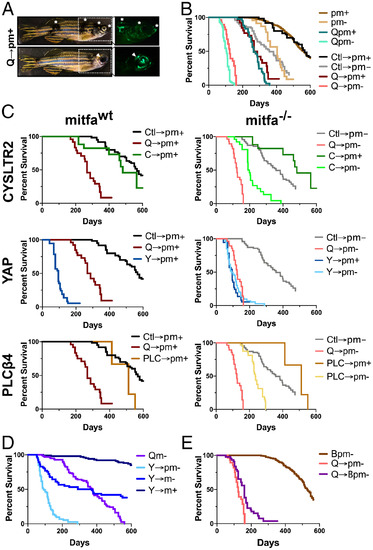
A mosaic expression system determines that CYSLTR2L129Q, YAPAA, and PLC?4D630Y can drive UM tumorigenesis. Mosaic zebrafish are denoted by X?Y, where X is the gene introduced, and Y is the recipient genotype; Ctl, control GOI?GFP vector; Q, GNAQQ209L; C, CYSLTR2 L129Q; Q, GNAQQ209L; Y, YAPAA; PLC, PLCB4D630Y. Germline zebrafish lines and recipient genotypes are as indicated in Figs. 1 and 2. (A) Representative zebrafish images confirm that introduction of GNAQQ209L via the GOI?GFP vector results in GFP+ pigment patches and tumors. Asterisks and arrows denote pigment patches corresponding to GFP expression. (B) Kaplan?Meier curves show that mosaic zebrafish with control vector or GNAQQ209L introduced into pm+ or pm? recipients all have overall survivals that closely mirror their germline pm+, pm?, Qpm+, and Qpm? equivalents (P = n.s.). As with the germline mutants, Q?pm+ versus Ctl?pm+ and Q?pm? versus Ctl?pm? were both significantly different (P < 0.001, as determined by log-rank test). (C) Kaplan?Meier curves show the effects of mosaic expression of CYSLTR2L129Q, YAPAA, and PLC?4D630Y in tp53-mutant zebrafish that are either mitfa+/+ (Left) or mitfa?/? (Right). Q?pm+, Q?pm?, Ctl?pm+, and Ctl?pm? data from B are shown for comparison. Statistical significance is as follows: CYSLTR2, C?pm+ versus Ctl?pm+ n.s., C?pm? versus Ctl?pm? P < 0.0001, as determined by log-rank test; YAP, Y?pm+ versus Ctl?pm+ P < 0.0001, Y?pm? versus Ctl?pm? P < 0.0001, as determined by log-rank test; PLC?4, PLC?pm+ versus Ctl?pm+ n.s., PLC?pm? versus Ctl?pm? P < 0.0001, as determined by log-rank test. (D) Kaplan?Meier curves show that YAP cooperates with mitfa?/? in a tp53-WT background. Overall survival of Y?m+ versus YAP?m?, significant to P < 0.0001, as determined by log-rank test. (E) Kaplan?Meier curves of Q?Bpm? versus Bpm? controls, with Q?pm? from B shown for comparison, show that GNAQQ209L is dominant over BRAFV600E in allowing tumors to form the mitfa?/? background. Statistical significance of overall survival is P < 0.0001 for Q?Bpm? versus Bpm? and P = 0.0003 for Q?Bpm? versus Q?pm?, as determined by log-rank test.
|